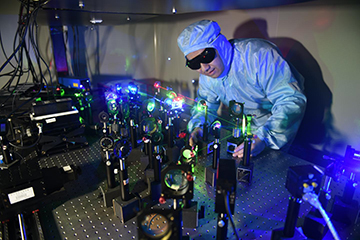
Shencheng Fu carries out experiments with a new nanoparticle film that can be used to holographically store data. [Image: Northeast Normal University / china]
Researchers from the Northeast Normal University in Changchun, China, report developing and testing a new type of nanoparticle film that they say can holographically store a thousand times more data than a DVD and can retrieve data at speeds 20 times faster than today’s flash memory drives (Opt. Mater. Express, doi: 10.1364/OME.8.001143). The new film is porous and made from the semiconductor titania (TiO2) and silver nanoparticles. By disrupting the electron flow through the nanoparticle film with “electron scavenger” molecules, the researchers were able to make a material that remains stable in the presence of normally destructive ultraviolet (UV) light. In demonstrations, the researchers also observed that the changed electron flow accelerated hologram-writing speed.
The researchers, led by Shencheng Fu, hope that their new porous nanoparticle film could someday be used as a storage medium in wearable tech that can capture large numbers of color 3-D images. “Because the storage medium is environmentally stable,” Fu said in a press release, “the device could be used outside or even brought into the harsh radiation conditions of outer space.”
Holographic data storage
Holographic data-storage methods use lasers to create and read millions of bits of data at once, whereas traditional optical and magnetic data-storage methods create and read data one bit at a time. Holographic methods also allow for high-density data storage and retrieval, because lasers can record holograms throughout the volume of the material, as well as record several holograms in the same location by using different angles and wavelengths.
Though holographic data storage sounds very promising—especially with “big data” growing in importance—the metal-semiconductor nanocomposite films commonly used as storage materials are highly susceptible to damage from exposure to UV light. When combined with visible-light exposure, UV light weakens recorded hologram optical stability and can overwrite holograms stored on the film.
Fu and his colleagues say they have found a way to make metal-semiconductor nanocomposite films that remain stable when exposed to UV light by manipulating the laser-initiated flow of electrons through the films.
Disrupting the electron flow
When a laser hits a titania-silver nanoparticle film, electrons flow from the titania film to the silver nanoparticles, which are converted into positively charged silver cations. This photo-transformation is what allows holograms to be written in and read from the film. However, exposing the film to UV light causes the same photo-transformation to occur, which can erase or overwrite the stored hologram.
Fu and his colleagues discovered that introducing “electron scavenger” tungstophosphate molecules into a porous titania-silver nanoparticle film blocked the destructive photo-transforming effects of UV light. The pores allow for the silver cations and electron scavengers to freely pass through and interact with the semiconductor film.
In laboratory demonstrations, the researchers observed that the film could holographically store and read data in the presence of UV light more efficiently than a standard nonporous titania-silver nanoparticle film without electron scavengers. They calculated the diffraction efficiency of the new film to be 63 percent higher than that for the standard film. The team also observed that the changed electron flow through the new film formed multiple electron-transferring paths that enhanced plasmon-induced charge separation, quickening film/laser response time and increasing data-writing speed.
